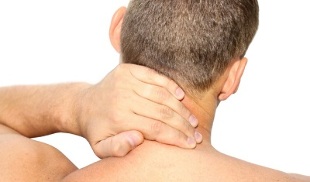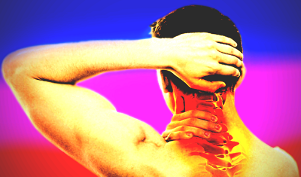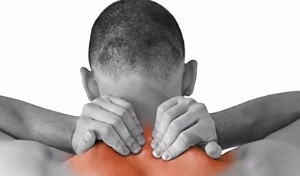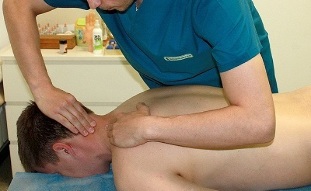The main symptom of cervical osteochondrosis is pain. There are a number of additional signs that will help determine the presence of degenerative spinal lesions in the cervical spine.
Pain occurs against the background of disorders in the peripheral region, this is due to the detrimental effect on nerve roots and claws that connect tissues, discs and muscles. With cervical osteochondrosis, men experience periodic or persistent pain. In the morning, the patient may feel dull pain deep in the neck.
Important! Unpleasant sensations occur with dizziness, coughing and sneezing.
Due to strong muscle tension, a man can not breathe deeply. The pain may radiate to the occipital part of the head, this indicates a lesion of the occipital nerve.

When touching the upper cervical vertebrae, a man may feel a painful lump. When nerve root compensation occurs, discomfort may radiate to the shoulder and arm area.
Cervical osteochondrosis is characterized by degenerative processes in the intervertebral discs.
Deterioration of blood flow to the nerve nodes leads to the following symptoms:
- burning pain in the back of the head;
- numbness of the hands at night;
- swelling of hands;
- irregular heartbeat;
- itching and crackling when you turn your head.
Vascular signs appear when the brainstem is affected. Osteochondrosis of the cervix disrupts normal blood flow to the vertebral arteries. Against the background of such pathological changes, neurotic failures occur:
- insomnia;
- unreasonable nervousness;
- rocking;
- dizziness;
- rapid heartbeat;
- excessive sweating;
- memory impairment.
In some cases, the performance of the visual apparatus deteriorates. The risk of osteochondrosis is that it provokes the development of the following syndromes:
- Stenosis. This is a narrowing of the spinal canal when the vessels of the brain are squeezed by herniated intervertebral discs. The upper and lower limbs begin to numb.
- Irritating reflex. This syndrome is accompanied by burning pain in the back of the head.
- Radical. With this pathology, the nerve roots are compressed by the intervertebral disc. The pain is aching, burning and throbbing.
In most cases, the symptoms of osteochondrosis in men are almost the same as in women. When the first attacks of pain occur, the patient does not always suspect that it is osteochondrosis of the cervix. Timely diagnosis will help avoid complications.
Diagnosis of cervical osteochondrosis
X-rays are taken to diagnose the disease. This will help ensure that there is no spinal cord injury. However, this research method does not offer an opportunity to look at osteophytes. For this, more modern diagnostic methods are used.

Scheduled Performance:
- computed tomography;
- magnetic tomography;
- ultrasound scan of the neck vessels.
Computed tomography involves creating a series of X-rays that show the cervical vertebrae in volume. Such a detail makes it possible to assess the nature of the nerve compression, the height of the discs, and the structure of the osteophytes.
Magnetic resonance imaging is considered one of the most informative diagnostic methods. Allows you to assess the condition of bone structures. During an MRI, the doctor can detect the presence of a hernia.
Duplex vascular scan is used if the doctor suspects bleeding disorders in the vertebral arteries.
Treatment of male osteochondrosis
Treatment is chosen depending on the degree of injury and the general well-being of the husband. In most cases, medication and physical therapy are recommended.
HELP.Conservative therapy aims to relieve pain and relieve muscle spasm.
Physiotherapy activates the regeneration processes in cartilage tissue. Such procedures may be part of a comprehensive treatment or an independent method.
The following procedures are set:
- Electrotherapy.The impact on the affected areas of the back is by means of an electric current. This manipulation activates blood circulation. Contraindications include the presence of a pacemaker or metal parts in the patient's body.
- Magnetotherapy.This method involves exposure to a constant magnetic field. A procedure takes 20 minutes.
- Laser therapy.Use helium-neon lasers. They enhance bioelectrical processes in the tissues of the nervous system. Has anti-inflammatory, analgesic and wound healing effects. The duration of exposure in one area does not exceed 2 minutes, the whole procedure takes about 14 minutes.
- Shock Wave Therapy. This type of exposure is rarely used, as there is much controversy about its effectiveness. Impact is provided through acoustic waves. They help to increase metabolism and activate blood microcirculation.
- Balneotherapy.Treatment is performed with mineral water and therapeutic mud. All beneficial substances penetrate the skin and act on receptors and nerve endings.
To restore the mobility of the affected area, gymnastic exercises should be performed. They will help strengthen muscle corsets and make ligaments more flexible. The first trainings should be done under the supervision of a trainer, as it is not the number of exercises performed that matters, but their technique.
Important!Surgical intervention is indicated if medical treatment and physical therapy have not brought the desired results.

This is called a cervical discectomy. The doctor immobilizes the affected segment and removes the hernia, which puts pressure on the spinal nerve. Over time, the beads grow together. 3-5 days after surgery, the patient is transferred to the outpatient clinic.
The duration of the rehabilitation period is about 3 months. The exact time of rehabilitation depends on the implant and the professional activity of the operated patient.
In any case, it is worth starting the treatment of cervical osteochondrosis with a visit to a doctor. Self-treatment can worsen the course of the disease and lead to surgery.
Drugs for treatment
Medications for osteochondrosis should only be taken as directed by your doctor. He designs a therapeutic regimen and chooses the optimal dose.
The following groups of drugs are described:
- analgesics;
- antispasmodics;
- anti-inflammatory drugs; vasodilators
- ;
- chondroprotectors.
HELP.Active ingredients not only relieve spasm, but also reduce the sensitivity of nerve endings.
Your doctor may prescribe the use of non-steroidal anti-inflammatory drugs. These medications relieve pain and reduce inflammation.
It is recommended to use medication to reduce blood viscosity as a vasodilator. They improve blood microcirculation. Taking such medications promotes rapid recovery after treatment of cervical osteochondrosis.
The action of chondroprotectors is to activate regeneration processes in damaged cartilage.

Wrongly selected treatment can lead to the formation of a disc herniation. With cervical osteochondrosis, hypertension often occurs. If necessary, the doctor prescribes medication to relieve the symptoms of such a pathological condition.
In order for drug treatment to be as effective as possible, it must be combined with therapeutic exercises and physiotherapy procedures.
After a chiropractic session, try not to shake your neck. The muscles after the procedure will be maximally relaxed and you can reduce the positive effect of the session.
Diet for osteochondrosis
With osteochondrosis, a man should pay special attention to his diet. It needs to be balanced, as the body needs to get a sufficient amount of vitamins and nutrients.
The following foods should be present in the diet:
- vegetables and herbs;
- berries and fruits;
- dairy and fermented milk products;
- protein rich foods;
- foods that contain gelatin and collagen.
Plant foods contain a lot of vitamins and fiber. They have low energy value, which contributes to maintaining a normal weight. Parsley, cauliflower, beets and broccoli are especially helpful.
Patients with osteochondrosis are advised to include buckthorn in their diet. Based on fruits and berries, you can prepare jelly. Fermented milk products contain a large amount of calcium, vitamin D and phosphorus. These vitamins and nutrients strengthen bones and cartilage tissue.
The following foods should be present in the daily menu:
- fermented baked milk; cheese
- without preservatives;
- kos;
- soft milk.
important It is important that dairy and fermented milk products are natural, free of dyes and other harmful additives. Protein is essential for the formation of bone and cartilage tissue. Most of it is found in eggs, milk, whole grains and brewer's yeast.
Fish and seafood will benefit. They contain unsaturated fatty acids and poly, which are necessary for the body's normal recovery. Collagen is present in jelly, aspic and aspic fish. It promotes cartilage tissue synthesis.
HELP.It is recommended to replace plain vegetable oil with extra virgin olive oil. It is important to maintain water balance.
Use only filtered or bottled water.
Most men visit a doctor when osteochondrosis is already at an advanced stage. There are a number of symptoms that indicate the development of a pathological condition. Timely diagnosis and treatment will help avoid surgery and complications.



































